Millions of Americans who recently began shopping for new health insurance coverage under Obamacare may be suffering from sticker shock.
Increases in 2016 premiums for health insurance coverage -- ranging from basic to top-flight policies -- will be in the double digits and easily eclipse premium hikes recorded between 2014 and 2015, according to a new analysis from consulting firm McKinsey & Co.
Related: Democrats Begin the Long, Tortuous Retreat from Obamacare
For instance, monthly premiums for the lowest-price Silver plan under the Affordable Care Act will rise by a median rate of 11 percent in the coming year, compared to just a 7 percent rate increase between 2014 and 2015, the study shows.
Across the board, the projected rate hikes for the lowest-priced options in each tier of coverage – Bronze, Silver, Gold and Platinum – will contrast sharply with those increases of the previous year.
The median cost of the Bronze plans, one of the most popular offerings because of its relatively low premiums, will rise by 13 percent in 2016, compared to the 7 percent increase in this year’s premium. As for the high-end health insurance coverage for wealthier consumers, Gold’s median premium rate will jump 15 percent compared to 8 percent last year while Platinum’s rate will rise by 12 percent, compared to 10 percent this year.
The premium increases shouldn’t come as much of a surprise because numerous health experts and critics of the program have been predicting sizeable increases since last summer. That’s when a number of major insurers across the country sought regulatory approval for significant increases for 2016 to cover higher than anticipated claims from sick people who re-enrolled for individual policies, according to the Wall Street Journal.
Related: An Obamacare Change to Medicare Is Backfiring
Senate Majority Leader Mitch McConnell (R-KY), a leading opponent of Obamacare, told reporters earlier this week, “If you look at how it unfolded over the years, everything we predicted is coming true. Higher premiums, higher co-payments, higher deductibles, lost jobs.”
The Affordable Care Act provides government subsidies in the form of federal tax credits for many lower-income Americans who must purchase insurance on their own because they can’t obtain it through an employer or through a government program like Medicare. The federal subsidies will blunt the impact of price increases for some but not all enrollees for the 2016 coverage season.
The price hikes will be a mixed bag throughout the country, with consumers in some states seeing relatively modest hikes while others slapped with median price increases for the lowest-price Silver plans of between 18 percent and 26 percent. According to the McKinsey study, consumers in Arizona will see a 20 percent increase, Montana and Tennessee 22 percent, Hawaii 25 percent and Oklahoma 26 percent.
According to Modern HealthCare, most enrollees on the federal-run insurance exchanges have chosen Bronze or Silver plans because of their relatively low premiums. From the looks of signups since the start of the new enrollment period on Nov 1, those two plans remain the most popular. However, a majority of the options have high deductibles, in which people could potentially be stuck with large medical expenses before insurance kicks in, the publication reported.
Related: House GOP Scores a Major Win in Obamacare Legal Challenge
Along those lines, Modern HealthCare cited the example of family of four living in Tinley Park, Ill, that makes $90,000 a year and has 69 health plan options available for 2016. But 58 of those 69 program options are considered high-deductible plans, meaning people covered by them must pay a certain percentage of their medical costs up-front before the coverage kicks in.
For the least expensive bronze plans, the average deductible for individuals is $5,731—and 11 percent increase. Silver plans are a little less onerous at $3,117 or an increase of 6 percent for individuals.






